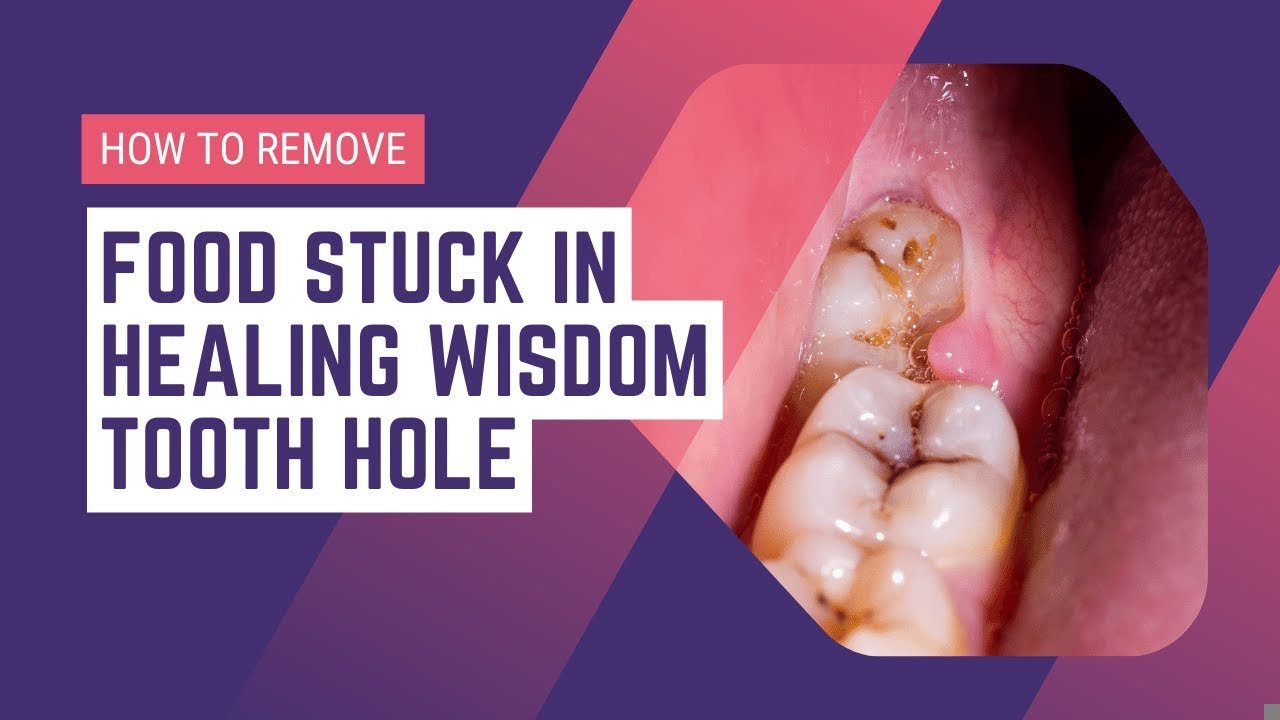Food stuck in the wisdom tooth hole can be annoying and uncomfortable, but fear not—simple solutions exist. Gently rinsing your mouth with warm salt water can help dislodge debris, providing much-needed relief.
Wisdom teeth often create tricky gaps where food loves to hide, leading to irritation or even infection. Regular brushing and flossing around these areas can help prevent future incidents and keep your mouth healthy.
Stay proactive about your dental care, and don’t hesitate to consult your dentist if issues persist. Taking care of your teeth will ensure a happier, healthier smile.
Food Stuck in Wisdom Tooth Hole: What You Need to Know
Sometimes, when you eat, you might feel something stuck in the back of your mouth, especially after having your wisdom teeth removed. This can happen if food gets lodged in the hole where the tooth used to be. Don’t worry! You’re not alone, and there are plenty of ways to handle it. Let’s take a deep dive into the world of wisdom teeth, food particles, and what you can do about it!
Understanding Wisdom Teeth
Wisdom teeth are the last set of molars that usually come in during your late teens or early twenties. For some people, they come in just fine, but for many, they can cause problems. Here’s what you should know:
- Location: Wisdom teeth are located at the back of your mouth, one on each side of your upper and lower jaw.
- Function: In the past, these teeth helped our ancestors grind down tough plant tissue. Today, they are often considered unnecessary.
- Impaction: Many people have jaws that are too small to accommodate these teeth, leading to impaction, which can cause pain and infection.
When wisdom teeth are removed, they leave a socket or hole in the gum. This area is delicate and can be a magnet for food particles!
Why Does Food Get Stuck?
When you eat, food can naturally end up in various spaces in your mouth. The socket left by a wisdom tooth is one of those spaces that can trap food. The reasons food gets stuck in the wisdom tooth hole include:
- Depth of the Socket: The hole can be deep and has uneven surfaces that easily catch food.
- Type of Food: Softer foods like bread or mashed potatoes can cling more easily than harder foods.
- Oral Hygiene: If you don’t clean the area properly, food can accumulate and cause discomfort.
Signs You Have Food Stuck in the Wisdom Tooth Hole
It can be tricky to tell if you have food stuck in your wisdom tooth socket. However, there are some common signs to watch for:
- Pain or Discomfort: A feeling of pressure or pain in that area can indicate food trapped in the socket.
- Swelling: The area might look swollen or feel tender to the touch.
- Bad Breath: If food is stuck, it can cause bad breath as it starts to decay.
- Visible Food Particles: Sometimes, you can actually see remnants of food in the hole.
If you experience these symptoms, it’s important to take action.
How to Remove Food Stuck in Wisdom Tooth Hole
If you suspect food is stuck, here are some safe and effective methods you can try:
Rinsing Your Mouth
One of the easiest ways to loosen food is by rinsing your mouth. Here’s how to do it:
- Mix a teaspoon of salt in a cup of warm water.
- Take a mouthful and swish it around your mouth.
- Make sure to focus on the area around the wisdom tooth socket.
- Spit it out and repeat a few times.
This method can help dislodge food and also soothe any swelling.
Using a Water Flosser
If you have a water flosser, you can use it to gently flush out the debris:
- Set the flosser to a low setting to avoid discomfort.
- Direct the stream of water at the socket.
- Make sure to angle it to reach the food particles effectively.
- Use short bursts of water rather than continuous pressure.
A water flosser can be very effective, especially if the food is stubborn.
Gentle Manipulation with a Cotton Swab
Sometimes using a cotton swab can help. Just be very gentle:
- Dampen a cotton swab with water or mouthwash.
- Gently insert the swab into the socket and try to dislodge the food.
- Be very careful not to push too hard, as you could irritate the area.
- Discard the swab after use and avoid using the same one on other areas of your mouth.
When to See a Dentist
If home remedies do not bring relief, or if you notice any serious symptoms, don’t hesitate to contact your dentist. Here’s when to seek professional help:
- If you experience severe pain that does not go away.
- If you notice excessive bleeding from the socket.
- If your mouth becomes swollen or you develop a fever.
- If bad smells or tastes persist even after cleaning.
Your dentist can examine the area and provide appropriate treatment.
Preventing Food from Getting Stuck
While you can’t completely prevent food from getting stuck, you can take steps to minimize the chances. Here are some tips:
- Maintain Good Oral Hygiene: Brush and floss daily, focusing on the areas around your wisdom teeth.
- Choose Softer Foods: In the days following surgery, try to eat softer foods that won’t break apart easily.
- Rinse Regularly: Rinse your mouth with saltwater after meals to help reduce food buildup.
- Follow Your Dentist’s Instructions: After any dental procedure, carefully follow the care instructions given by your dentist.
The Importance of Aftercare for Wisdom Tooth Removal
After removing a wisdom tooth, proper care is essential for healing and preventing complications. Here’s what you should do:
Follow Post-Surgery Instructions
Your dentist will give you specific aftercare instructions. These might include:
- Avoiding hard, crunchy, or chewy foods for a certain period.
- Taking prescribed medications as directed.
- Applying ice packs to reduce swelling.
Following these instructions helps promote healing and minimizes the risk of food getting stuck.
Adjust Your Eating Habits
After surgery, it’s best to pay attention to what you eat. Here are some suggestions for eating habits:
- Eat Soft Foods: Foods like yogurt, applesauce, and smoothies are gentle on your healing gums.
- Cut Food into Small Pieces: This will make it easier to chew and less likely to get lodged in the socket.
- Chew on the Opposite Side: If possible, try to chew food on the side of your mouth that is not affected.
Changing your eating habits for a little while can greatly help in recovery.
Additional Tips for Comfort
Dealing with food stuck in the wisdom tooth hole can be uncomfortable. Here are some additional tips to ease discomfort:
- Use Over-the-Counter Pain Relievers: Medicines like ibuprofen can help reduce pain and swelling.
- Apply Warm Compresses: If you experience swelling, a warm compress can help soothe the area.
- Stay Hydrated: Drinking plenty of fluids can help keep your mouth moist and aid in washing away food particles.
Staying comfortable during recovery is key to a quicker healing process.
Foods to Avoid
Certain foods can irritate the socket or get stuck more easily. It’s a good idea to avoid these:
- Hard Foods: Nuts, seeds, and chips can be too crunchy and might lodge in the socket.
- Sticky Foods: Caramels and gum can cling to the gum and be difficult to remove.
- Spicy Foods: These can irritate sensitive areas and cause discomfort.
Being mindful of what you eat can prevent extra discomfort during the recovery phase.
In summary, dealing with food stuck in the wisdom tooth hole can be a nuisance, but understanding how to remove it and what to avoid can make a big difference. Keeping up with oral hygiene and following your dentist’s advice are crucial for recovery. If problems persist, don’t hesitate to seek professional help. Taking care of your mouth will help you feel better faster and get you back to enjoying your favorite foods!
How to remove food stuck in healing wisdom tooth hole?
Frequently Asked Questions
What should I do if food gets stuck in my wisdom tooth hole?
If food gets stuck in your wisdom tooth extraction site, gently rinse your mouth with warm salt water to help dislodge the particles. You can also use a soft toothbrush or a rubber-tipped dental instrument to carefully remove any food debris. Avoid using sharp objects as they may harm the healing tissue. If discomfort persists, consult your dentist.
How can I prevent food from getting stuck in the wisdom tooth hole?
To prevent food from getting trapped in the wisdom tooth hole, avoid hard and chewy foods during the healing process. Opt for soft foods that are less likely to stick to the extraction site. Additionally, maintaining good oral hygiene by brushing gently and rinsing with salt water can help keep the area clean and minimize the risk of food getting trapped.
Is it normal for food to get stuck after wisdom tooth extraction?
Yes, it can be normal for food to get stuck in the wisdom tooth extraction site during the healing process. The area is still sensitive and may have uneven surfaces that easily trap food particles. However, if this happens frequently or if you experience pain and swelling, reach out to your dentist for advice.
When should I contact my dentist about food stuck in my wisdom tooth hole?
You should contact your dentist if food remains stuck for an extended period, especially if it’s causing pain, swelling, or signs of infection, such as pus or fever. Additionally, if you notice an unusual odor coming from the extraction site, it’s important to seek professional help.
Can using a water flosser help remove food from the wisdom tooth hole?
Yes, using a water flosser can assist in cleaning the wisdom tooth extraction site by providing a gentle stream of water that helps dislodge food particles. Use it on a low setting to avoid causing discomfort or disturbing the healing tissue. Always consult your dentist for tailored advice based on your specific situation.
Final Thoughts
Food stuck in wisdom tooth hole can be an uncomfortable experience. It’s essential to address any debris trapped in this area to prevent irritation or infection. Regular dental hygiene plays a crucial role in minimizing these issues.
If you find food in your wisdom tooth hole, rinse with warm salt water or use a soft toothbrush to gently dislodge it. If problems persist, consulting your dentist will ensure proper care and advice. Prioritizing oral health helps you avoid complications related to food stuck in wisdom tooth hole.




